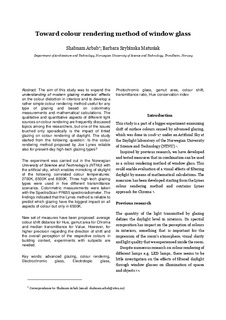| dc.contributor.author | Arbab, Shabnam | |
| dc.contributor.author | Matusiak, Barbara Szybinska | |
| dc.date.accessioned | 2019-05-13T09:19:06Z | |
| dc.date.available | 2019-05-13T09:19:06Z | |
| dc.date.created | 2018-11-02T10:01:44Z | |
| dc.date.issued | 2018 | |
| dc.identifier.citation | Color Research and Application. 2018, 1-10. | nb_NO |
| dc.identifier.issn | 0361-2317 | |
| dc.identifier.uri | http://hdl.handle.net/11250/2597374 | |
| dc.description.abstract | The aim of this study was to expand the understanding of modern glazing materials' effects on the colour distortion in interiors and to develop a rather simple colour rendering method useful for any type of glazing and based on colorimetry measurements and mathematical calculations. The qualitative and quantitative aspects of different light sources on colour rendering are frequently discussed topics among the researchers, but one of the issues touched only sporadically is the impact of tinted glazing on colour rendering of daylight. The study started from the following question: Is the colour rendering method proposed by Lynes reliable also for present‐day high‐tech glazing types? The experiment was carried out in the Norwegian University of Science and Technology's (NTNU) with the artificial sky, which enables mimicking of skylight of the following correlated colour temperatures: 2700 K, 6500 K and 8000 K. Three high‐tech glazing types were used in five different transmittance scenarios. Colorimetric measurements were taken with the SpectraScan PR655 spectroradiometer. The findings indicated that the Lynes method is reliable to predict which glazing have the biggest impact on all aspects of colour but only in 6500 K. New set of measures have been proposed: average colour shift distance for hue gamut area for Chroma and median transmittance for Value. However, for higher precision regarding the direction of shift and the overall perception of the respective colours in building context, experiments with subjects are needed. | nb_NO |
| dc.language.iso | eng | nb_NO |
| dc.publisher | Wiley | nb_NO |
| dc.title | Toward colour rendering method of window glass | nb_NO |
| dc.title.alternative | Toward colour rendering method of window glass | nb_NO |
| dc.type | Journal article | nb_NO |
| dc.type | Peer reviewed | nb_NO |
| dc.description.version | acceptedVersion | nb_NO |
| dc.source.pagenumber | 1-10 | nb_NO |
| dc.source.journal | Color Research and Application | nb_NO |
| dc.identifier.doi | 10.1002/col.22247 | |
| dc.identifier.cristin | 1626291 | |
| dc.description.localcode | Locked until 7.9.2019 due to copyright restrictions. This is the peer reviewed version of an article, which has been published in final form at [https://doi.org/10.1002/col.22247]. This article may be used for non-commercial purposes in accordance with Wiley Terms and Conditions for Self-Archiving. | nb_NO |
| cristin.unitcode | 194,61,55,0 | |
| cristin.unitname | Institutt for arkitektur og teknologi | |
| cristin.ispublished | true | |
| cristin.fulltext | original | |
| cristin.qualitycode | 1 | |
